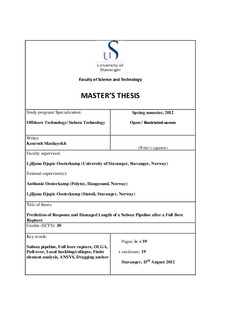| dc.contributor.author | Mashayekh, Kourosh | |
| dc.date.accessioned | 2012-12-19T09:27:10Z | |
| dc.date.available | 2012-12-19T09:27:10Z | |
| dc.date.issued | 2012 | |
| dc.identifier.uri | http://hdl.handle.net/11250/182978 | |
| dc.description | Master thesis in Offshore technology | no_NO |
| dc.description.abstract | The combination of oil and gas reservoirs in sea areas with high shipping traffic brings some challenges for engineers. One of these challenges is related to subsea pipeline systems specially where water depth is classified as shallow or intermediate. Due to large number of vessels passing the area with shallow water depth, interaction between anchors of these vessels and the offshore pipeline can occur. If a dragging anchor hits and subsequently hooks the pipeline, the pipeline could be ruptured. When an offshore pipeline ruptures while it is in operational mode, the operation must be stopped immediately and a repair team has to repair the pipeline system as quick as possible. On the key steps for repairing the pipeline is to remove and replace damaged length of the pipeline. Hence evaluation of the damage length is important. In this project, the response of a ruptured pipeline by an anchor load was studied to predict and define the damaged length. In order to solve the problem, the solution method is split in three parts. In first step, the flow condition of hydrocarbons inside the pipeline as well the fluid interaction with the pipeline is calculated using one dimensional pipe flow software OLGA. During the second step, the mechanical response of the pipeline to load applied by the caught anchor is determined. The reaction of the pipeline from the moment after impact until rupture is studied using finite element analysis. ANSYS Workbench 14 software is used in this step. The third step determines the deformation of the subsea pipeline after rupture. A jet of released hydrocarbons will lead to a thrust force on the ruptured cross‐section. This force causes the ruptured pipeline to buckle. Purpose of this part is to identify where local buckling occurs and whether the pipeline collapses due to buckling or not. If the pipeline fails at buckled region, pipe’s sections from the buckled pipe’s cross‐section to ruptured pipe’s cross‐section have to be cut. This step is also done with finite element analysis using the ANSYS software. In this project a pipe section with length of 3000 m and outer diameter of 42’’ is modelled in ANSYS. Obtained results show that the displacement of the pipeline before rupture is already severe. According to the results, after rupture, the result is thrust force leads to either sides of the ruptured pipeline to buckle and fail at two regions. Hence, repair team has to cut the pipeline from the buckled pipe’s crosssections. The thrust force from the escaping fluid jet leads to additional length of pipe to be cut. | no_NO |
| dc.language.iso | eng | no_NO |
| dc.publisher | University of Stavanger, Norway | no_NO |
| dc.relation.ispartofseries | Masteroppgave/UIS-TN-IKM/2012; | |
| dc.subject | offshore technology | no_NO |
| dc.subject | offshore teknologi | no_NO |
| dc.subject | subsea technology | no_NO |
| dc.subject | pipeline | no_NO |
| dc.subject | full bore rupture | no_NO |
| dc.subject | local buckling/collapse | no_NO |
| dc.subject | finite element analysis | no_NO |
| dc.subject | ANSYS | no_NO |
| dc.subject | dragging anchor | no_NO |
| dc.title | Prediction of response and damaged length of a subsea pipeline after a full bore rupture | no_NO |
| dc.type | Master thesis | no_NO |
| dc.subject.nsi | VDP::Technology: 500::Marine technology: 580::Offshore technology: 581 | no_NO |
